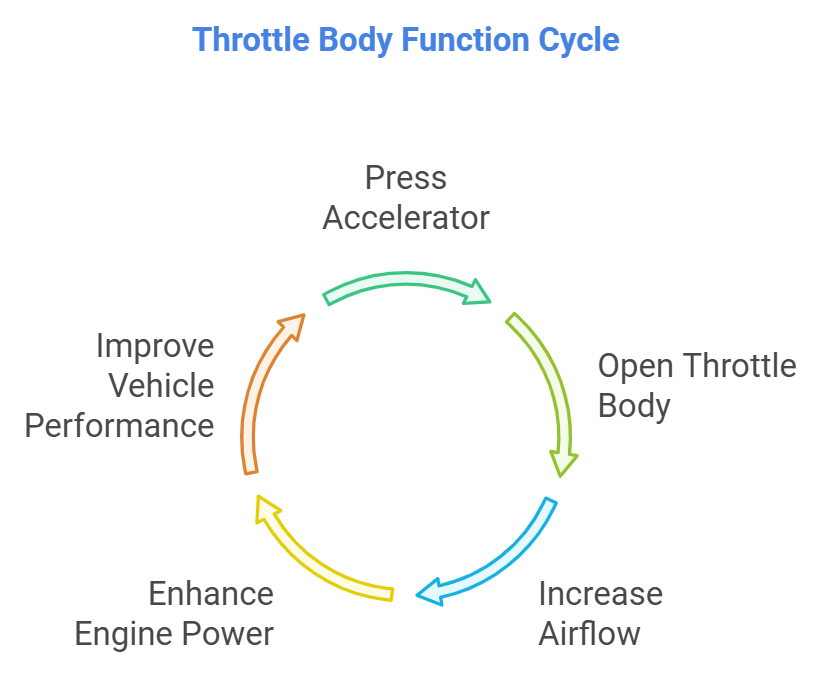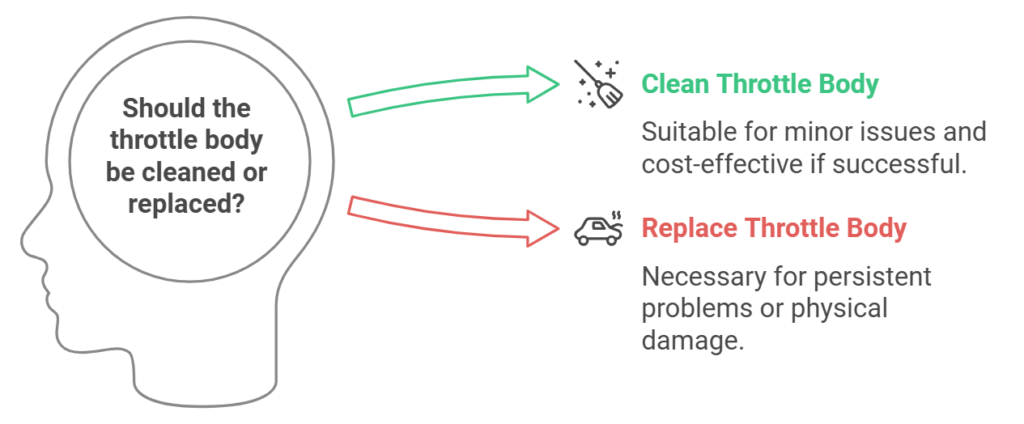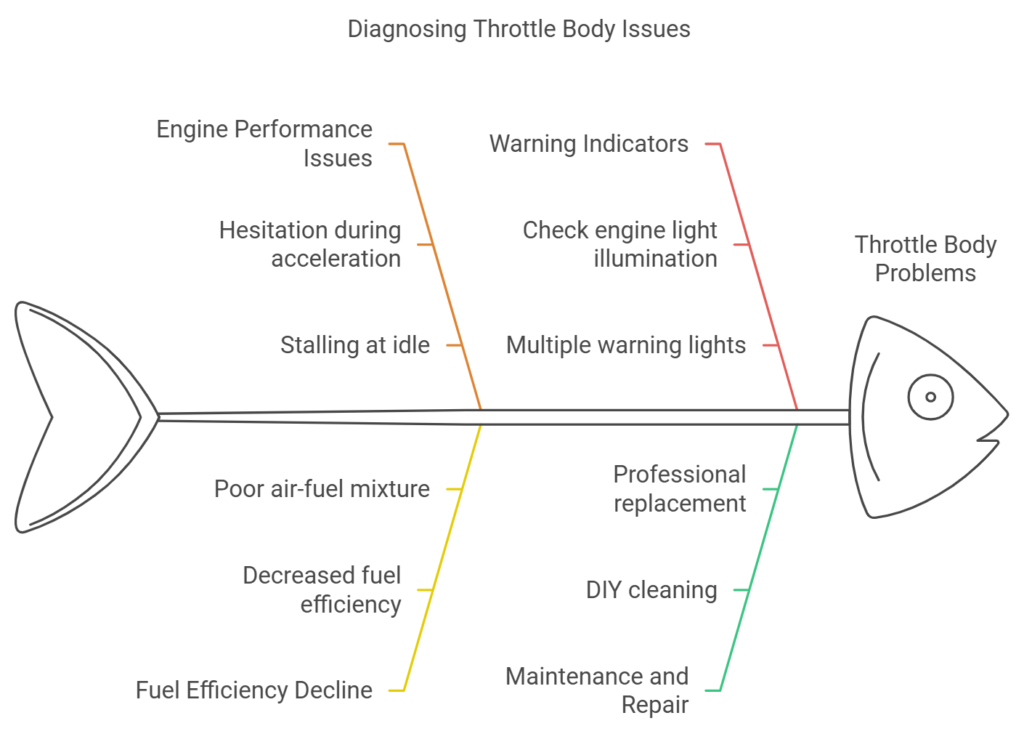I. Understanding the Throttle Body
A. Definition and Function
The throttle body is a crucial of your vehicle’s air intake system. It serves as a gateway for air to enter the engine, playing a vital role in controlling the engine’s power and efficiency. Essentially, when you press the accelerator, the throttle body opens to allow more air in, thus enabling the engine to produce more power. An optimally functioning throttle body is vital for overall engine performance, as it directly influences acceleration, speed, and fuel efficiency.

B. Location within the Engine System
The throttle body is typically located between the air filter and the intake manifold. To visualize its position, imagine a funnel leading air into your engine, with the throttle body situated in the middle of this funnel. It connects to various components, including sensors that monitor air intake and manage airflow. With advances in technology, many vehicles now utilize electronic throttle bodies, which use sensors and electronic controls, as opposed to the traditional mechanical throttle bodies that rely on a direct linkage to the accelerator pedal.
C. Common Issues Associated with a Throttle Body
Over time, the throttle body can accumulate dirt and debris, which can hinder its performance. Other common issues include wear and tear of internal components, leading to issues with how fuel and air flow into the engine. Such problems can seriously affect your vehicle’s performance, resulting in reduced fuel efficiency, sluggish acceleration, and poor overall drivability.
II. Key Warning Signs of Throttle Body Problems
A. Unusual Engine Performance
One of the first indicators of a potential throttle body issue is unusual engine performance. You might notice a significant power loss during acceleration, which can be frustrating, especially when merging onto highways. Additionally, you could experience stalling or hesitation, where the vehicle struggles to maintain speed or suddenly loses power. Changes in idle speed—such as an unusually high or low idle—can also signal a problem with your throttle body.
B. Warning Lights and Dashboard Indicators
Modern vehicles are equipped with sophisticated diagnostic systems that alert you to potential issues. If your check engine light comes on, it might be an indication of throttle body trouble. Other warning lights related to engine performance could also appear. It’s crucial to perform diagnostic testing when these lights activate, as they can help pinpoint the specific issues affecting your vehicle.
C. Changes in Fuel Efficiency
Another sign of a malfunctioning throttle body is a noticeable change in fuel efficiency. If you find yourself making more trips to the gas station, it may be time to investigate. Reduced fuel efficiency could stem from improper air-fuel mixture due to throttle body dysfunction. If not addressed, these changes can lead to long-term implications for your wallet and the environment.
III. Diagnostic Methods for Throttle Body Issues
A. Visual Inspection
As a vehicle owner, performing a basic visual inspection of your throttle body can be very insightful. Look for signs of physical damage or dirt buildup around the throttle body housing. Cleaning any visible grime can help maintain proper function. Remember, a clean throttle body is essential for smooth air intake and engine performance.
B. OBD-II Scanner Use
Utilizing an OBD-II scanner can provide critical information about your vehicle’s health. This device reads error codes related to various components, including the throttle body. Understanding these codes can give insights into whether the issue is with the throttle itself or another related component. Learning how to read and interpret these codes can empower you as a car owner.
C. Professional Diagnostics
If you’re unable to identify the problem using visual inspection or an OBD-II scanner, it might be time to consult a mechanic. Professional diagnostics typically involve a comprehensive examination of your vehicle’s systems. During this process, mechanics can identify aftermarket modifications or component failures that might contribute to throttle body issues. Keep in mind that the cost of diagnostics can vary based on your location and the complexity of the issues.
IV. Solutions to Throttle Body Issues
A. Cleaning the Throttle Body
If you find that dirt buildup is affecting throttle body performance, consider cleaning it. Start by safely removing the intake duct to access the throttle body. Use a suitable throttle body cleaner and a soft cloth to remove residue. Avoid using harsh chemicals that could damage sensitive components. A successful cleaning can lead to improved performance and responsiveness

B. Replacing the Throttle Body
In some cases, cleaning might not suffice, and replacement may be necessary. Signs that indicate replacement include persistent warning lights, continuous stalling issues, or physical damage to the throttle body itself. The process typically involves disconnecting the battery, removing the throttle body, and installing a new one. Costs will vary based on your vehicle make and model, so it’s advisable to get multiple quotes from trusted mechanics.

C. Preventative Maintenance Tips
To prolong the life of your throttle body, regular vehicle inspections are crucial. It’s a good habit to clean your throttle body every couple of years, or sooner if you notice performance issues. Always refer to your vehicle’s manual for recommended service intervals, and take note of any unusual symptoms that may arise.
The Importance of Addressing Throttle Body Issues Promptly
A. Consequences of Ignoring Symptoms
Ignoring the early warning signs of a bad throttle body can lead to a cascade of problems. A malfunctioning throttle body position sensor can disrupt the engine’s air-fuel mixture, resulting in decreased fuel efficiency and increased emissions. Over time, this can lead to more serious issues like engine misfires, stalling, and difficulty starting your vehicle.
B. Enhancing Vehicle Performance Through Maintenance
Regular throttle body service is essential for maintaining optimal engine performance. By performing a thorough throttle body cleaning using a specialized throttle body cleaner, you can remove carbon buildup and ensure smooth airflow. A clean throttle body can lead to improved acceleration, smoother idling, and better overall responsiveness.
C. Building a Relationship with Your Mechanic
A trusted mechanic can help identify and address throttle body issues before they escalate. They can inspect your vehicle for signs of a failing throttle body sensor or other related problems. By establishing a strong relationship with your mechanic, you can proactively maintain your vehicle’s health and avoid costly repairs.
Conclusion
By understanding the role of the throttle body and its components, you can take proactive steps to ensure your vehicle’s longevity and performance. Don’t hesitate to address any throttle body issues promptly. Regular maintenance, including throttle body cleaning and inspections, can save you time, money, and frustration in the long run.
FAQs
-
What are the signs of a failing throttle body?
-
Hesitation during acceleration
-
Stalling at idle
-
Rough idle
-
Decreased fuel efficiency
-
Check engine light illumination
-
-
Can I clean my throttle body myself?
-
Yes, with the right tools and cleaning solution, you can clean your throttle body at home. However, it’s essential to follow the manufacturer’s instructions and exercise caution.
-
-
How much does it typically cost to replace a throttle body?
-
The cost of replacing a throttle body can vary depending on the vehicle make and model. It’s best to consult with a mechanic for an accurate estimate.
-
-
What role does the throttle body play in fuel efficiency?
-
The throttle body controls the amount of air entering the engine. A clean and well-functioning throttle body ensures optimal air-fuel mixture, leading to improved fuel economy.
-
-
When should I seek professional help for throttle body issues?
-
If you’re experiencing persistent issues, such as severe performance problems or multiple warning lights, it’s advisable to consult a qualified mechanic. They can diagnose the problem accurately and recommend the appropriate solution.
-

